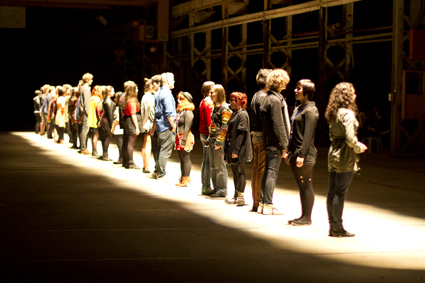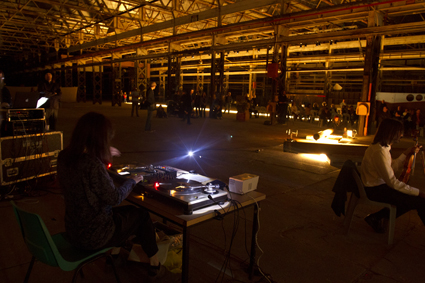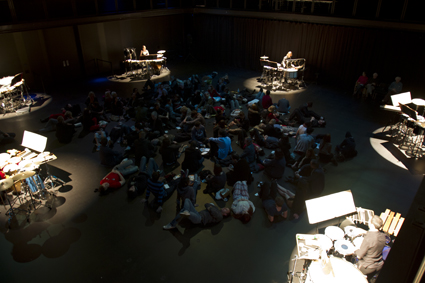 |
Marina Rosenfeld's Teenage Lontano, THNMF 2011 photo © Brad Serls |
RealTime was invited to be onsite to cover the 10th incarnation of the festival and in this task I was ably assisted by two Perth-based writers and composers, Sam Gillies and Henry Andersen. A selection of their reviews follows this conference report. The full coverage can be found here including video interviews with Marina Rosenfeld, composer in residence and Eugene Ughetti, artistic director of Speak Percussion, company in residence.
thnmf conference: materials & conditions
The Totally Huge New Music Conference was a key part of the festival bringing together many of the visiting artists to discuss their work with reference to the theme of “immanence.” Conference conveners Lindsay Vickery and Tos Mahoney proposed that the “slippery nature of contemporary culture and postmodern phenomena, such as the deconstruction of identity and distrust in metanarrative, arguably squeeze the individual into reliance only upon the present moment” (website). Due to writing commitments I could only attend the Saturday sessions of the conference covered here.
 |
Marina Rosenfeld (foreground), Cannons performed by Decibel, THNMF 2011 photo © Brad Serls |
New Zealand artist Bruce Russell, member of the band the Dead C and cultural critic, presented a paper titled “’No more driver call me, many thousand die’: improvised noise considered as twenty-first century field hollers and prison songs.” Starting with Alan Lomax and his recordings of early 20th century blues, Russell drew parallels with contemporary noisemaking in its potential for resistance and rebellion or, more accurately, its refusal to engage with a mainstream oppressive hegemony. Citing theorist of the moment, Slavoj Zizek he suggested that in this current technocratic age sound workers are proletariats and the role of noise “the reply to which there is no reply,” though ironically his paper created much by way of engaged response.
Nat Bates, director of Liquid Architecture directly approached the topic of immanence with his paper “Sampling and the ‘sound object’ in contemporary Sonic Art.” A fine example of practice as research he analysed each sound object or unit in Bernard Parmegiani’s musique concrète piece La Création du Monde and developed corresponding sounds from a palette of rock samples. In this way he equated the acousmatic with immanence—a material listening—and the non-acousmatic with transcendence—as causal and signified. In his use of contemporary music samples Bates also touched upon John Osborne’s Plunderphonics and its commentary on the cultural signification of sonic material. He concluded by quoting Mitchell Whitelaw’s concept of transmateriality—sounds constantly moving between states of immanence and transcendence—echoing Marina Rosenfeld’s idea of shifting between neutrality and universality.
Another stimulating conversation was prompted by a paper by Nicholas Russo who explored how contemporary Australian pop music seems caught in a time-machine set to golden era of rock, 1963-74, with comparative examples which suggest some bands, in their homage, are verging very close to plagiarism. Cat Hope explored the line in graphic musical notation and its translation into sound as glissandi, with reference to historical examples and in her own compositions for Decibel (see review).
Near the end of the day Anthony Pateras offered a provocation, suggesting that in this age of cross-disciplinarity and collaboration a composer should seek a sense of aloneness in their creative pursuits. Borrowing Lacan’s dialectic of love and desire—equating love with style and acceptance and desire with technique and no concern for the other—Pateras suggested that contemporary technology that connects us and offers alternative modes of distribution, is actually creating an over reliance on peer approval. He asked: is the superfluity of music, the plethora of stylistic trends and the ability to self-publish and instantly receive responses actually damaging young composers’ ability to think for themselves?
Over three days, the conference explored a vast range of approaches to the idea of immanence including discussions around Black Metal, Dubstep, site specific jazz, audiovisual interfaces and minimalist guitar music. Providing an opportunity for emerging and established artists to present papers there was plenty to reflect on and from varied perspectives. As with the last three THNMF Conferences, the papers will also be published (with Sound Papers Three coming out in time for this event) adding a valuable resource for the study of Australian music.
moments of substance
 |
Speak Percussion, Le Noir de l'Etoile photo © Brad Serls |
What was perhaps was most refreshing about this Totally Huge was its engagement with younger artists, both as creators and audiences. With strong connections to the academy through events such as the conference (co-presented with WAAPA Edith Cowan University) and the Break Out Young Composers’ Night, the involvement of young musicians and singers in Teenage Lontano and associated events such as NoizeMachinn!! (see review), the next generation of composers and musicians are receiving valuable opportunities. This and exposure to the inspirational artists that Totally Huge presented such as Marina Rosenfeld and Speak Percussion is definitely providing further nourishment—that extra something in the water—to the fertile ground for new music that Perth has become.
TURA, Totally Huge New Music Festival, various venues, Sept 15-25; Totally Huge New Music Conference, conveners, Lindsay Vickery, Tos Mahoney, co-ordinator Sonja van Thiel; presented by Tura and the Music Research Group, CREATEC and the Western Australian Academy of Performing Arts [WAAPA], Edith Cowan University, Sept 16-18,?Perth Institute of Contemporary Arts; http://www.tura.com.au/totally-huge-music-festival/about
For full coverage go to features
RealTime Associate Editor Gail Priest was a guest of the Totally Huge New Music Festival 2011, with thanks to Tos Mahoney (Artistic Director), Gabrielle Sullivan (General Manager), Alison Weburn (Publicity), Chris de Groot (Young & Emerging Artists Project Coordinator) and Cat Hope (CREATEC).
RealTime issue #106 Dec-Jan 2011 pg. 36
© Gail Priest; for permission to reproduce apply to [email protected]








 back
back